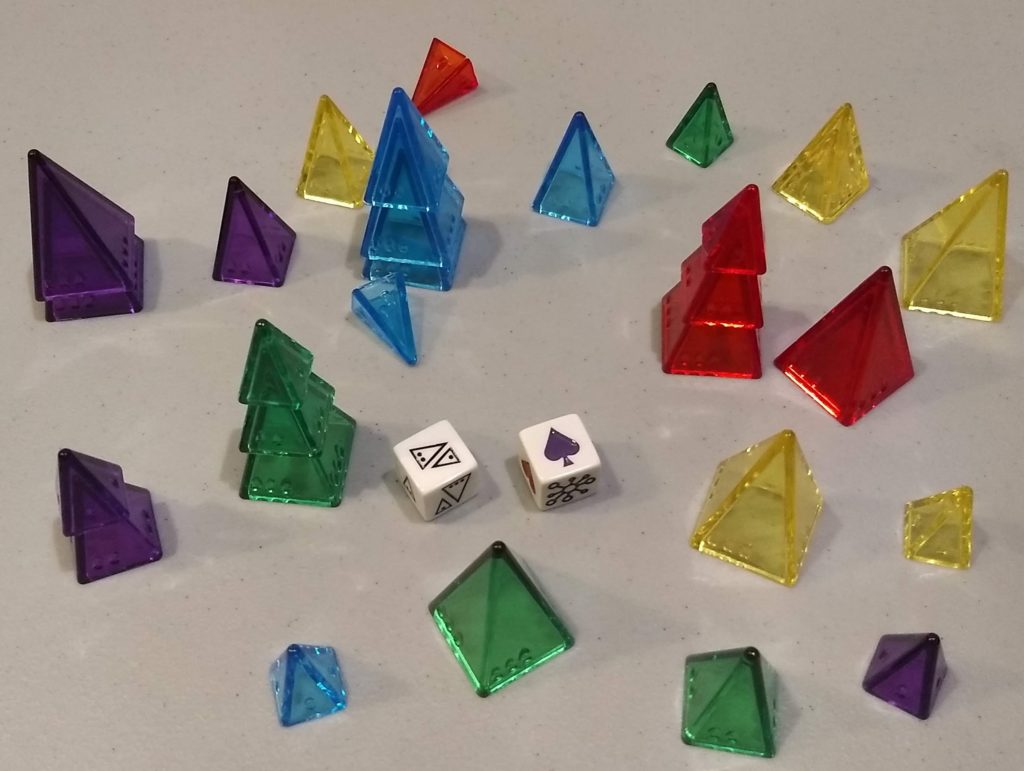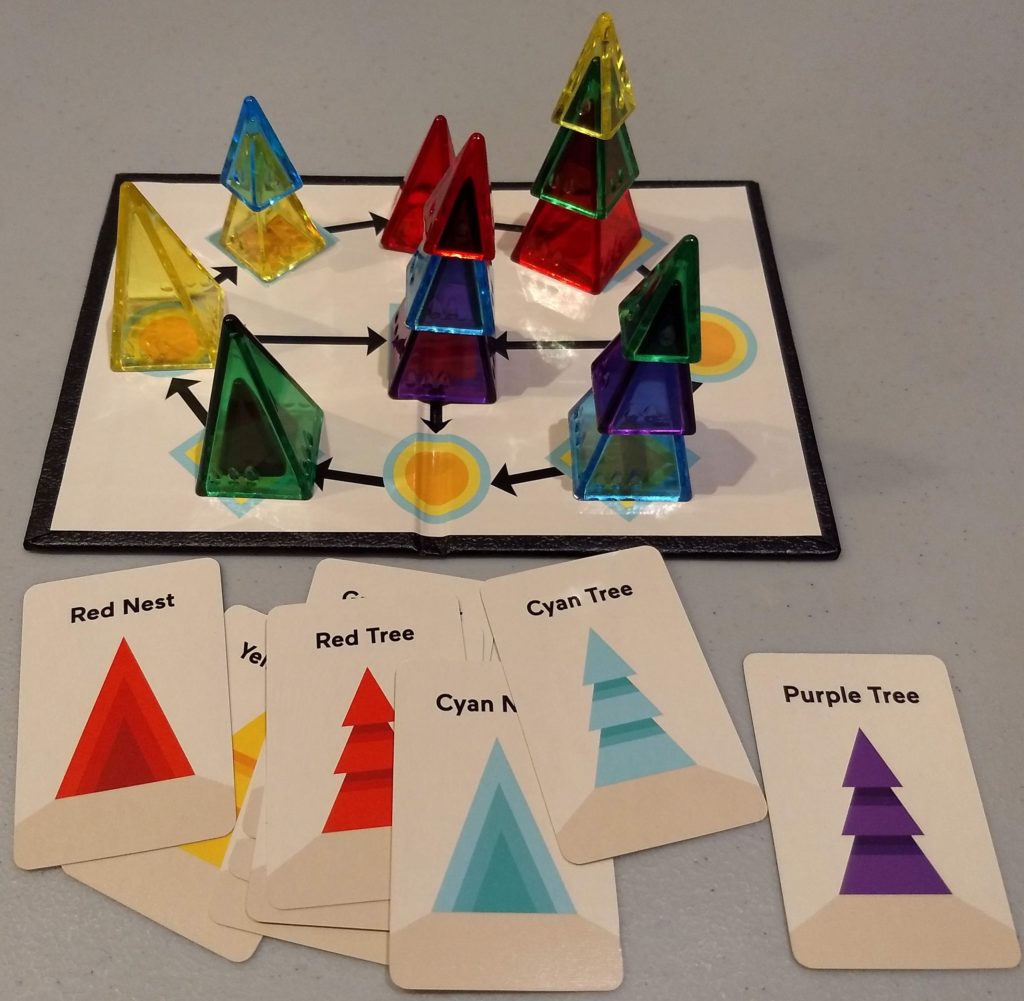Unplugged: Ice Duo (Boardgame)
:strip_icc()/pic5241313.jpg) Loony Labs has two solid game lines going for it. One is the chaotic but entertaining line of Fluxx games, and the other is its line of games based around a set of of colored plastic pyramids. Sold in many different ways, the pyramid line is now available in several small box releases. Ice Duo, reviewed here, is actually two games in one. Ice Dice is a push your luck style game of rolling dice to collect pyramids while Twin Win has players moving pyramids around the board in order to arrange them in a specific (secret) configuration for the win.
Loony Labs has two solid game lines going for it. One is the chaotic but entertaining line of Fluxx games, and the other is its line of games based around a set of of colored plastic pyramids. Sold in many different ways, the pyramid line is now available in several small box releases. Ice Duo, reviewed here, is actually two games in one. Ice Dice is a push your luck style game of rolling dice to collect pyramids while Twin Win has players moving pyramids around the board in order to arrange them in a specific (secret) configuration for the win.
Ice Duo (Ice Dice & Twin Win)
Designer: Andrew Loony
Publisher: Looney Labs
Players: 2
Ages: 8+
Time: 15-30min
(review copy provided by publisher)
First, a brief explanation of the pyramid system. Like a deck of cards, Looney Labs pyramids can be thought of as the building blocks for many different games. Pyramids come in many different colors, each appearing as a set of stackable pyramids of three different sizes, called a “trio”. The pyramids also have pips on them, with the largest pyramids having 3 pips, mediums 2 pips, and the smallest have a single pip. There are freely available rules for dozens of games that can be played with the appropriate number and colors of pyramids. (I highly recommend Zendo, which is like the old color-guessing game of Mastermind, only ramped up a notch.) Ice Duo is part of a new line of small-box games that contain everything needed to play one (or two, in this case) specific games. However, the pyramids from several of these small-box games could be combined to play many of the other pyramid games.

Ice Dice is my favorite of the two games included in the box. This game is played with a pair of special dice and 2 pyramid sets of five different colors (for a total of 10 “trios”.) The players’ goal is to be the first to collect three complete single-color sets of pyramids. At the start of their turn, a player rolls both dice. One die will display a color (or wild card) while the other die will indicate one (or two) sizes of pyramids. The player then selects one pyramid from the “bank” that matches the dice rolled. They can then “cash in” and move that pyramid into their play area, or they can keep going by rerolling the dice and choosing another pyramid. However, if the dice indicate a player must collect a pyramid of a previously rolled color, the player forfeits all pyramids collected this turn and their turn ends. However, if a player manages to collect one pyramid of each color during their turn, they can immediately claim those and take another turn. At the start of the game, the bank consists of two pyramids of every color and size. If a player must (or chooses to) collect a pyramid that is not in the bank, they can steal it from the other player. The first player to collect three sets (small, medium, large) of pyramids of a single color (ie. three “trios”) wins the game. While the game obviously relies on a fair bit of luck, the decision to continue and which pyramid to take (if you have multiple options) provide players some degree of control.

Twin Win, however, has very little randomness. Play starts with one trio of each of the five colors, which are then mixed up and placed in stacks on the board to make trees (large piece on the bottom, medium in the middle, and small at the top) of three different colors. Each player is then given two goal cards displaying either a tree or a nest (stacks from small to large) of a single color. Players then take turns moving the pieces around the board, trying to create a stack that matches either of their goal cards. Players get two moves a turn and may only move the topmost pyramid of any stack one space (although one could move a single piece two spaces by using both moves on the same piece.) A player may forgo one of their moves to trade in one of their goal cards to draw a different one from the deck. If any stack is created matching a player’s goal card, that player immediately wins the game.
Verdict:
I love the pyramid system as they are both cool-looking on the table and highly versatile. I mentioned how much I enjoy Zendo and highly recommend it as an example of deductive reasoning. However, since games are essentially limited almost entirely to using just the pyramids, games are by necessity tend to feature abstract games with simple rules. (That doesn’t mean the games aren’t deep.) In this set, the games stand on the lighter end of the spectrum. I think Ice Dice stands up better for me. It plays quick and balances between rewarding players making good decisions and allowing room for a player to just go for broke. Twin Win is more contemplative, and if I’m going to play a game of that sort, I tend to favor games with just a bit more theme and variety.
Kid Factor
Neither of these titles require reading and Ice Dice in particular is extremely kid-friendly. The listed 8+ years could easily go much younger. Twin Win might be too slow and think-y for the very young but there isn’t much in the rules to prevent them from giving it a go.





Discussion Area - Leave a Comment